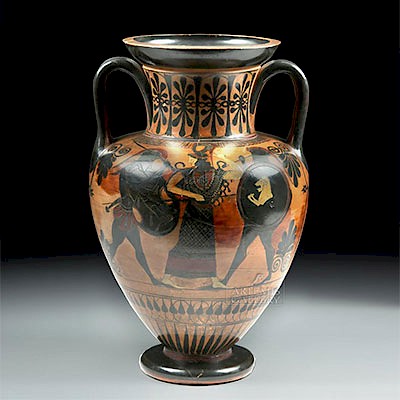Greek Illyrian Bronze Hoplite Helmet
Lot 11
About Seller
Artemis Fine Arts
686 S Taylor Ave, Ste 106
Louisville, CO 80027
United States
Selling antiquities, ancient and ethnographic art online since 1993, Artemis Gallery specializes in Classical Antiquities (Egyptian, Greek, Roman, Near Eastern), Asian, Pre-Columbian, African / Tribal / Oceanographic art. Our extensive inventory includes pottery, stone, metal, wood, glass and textil...Read more
Estimate:
$28,000 - $38,000
Absentee vs Live bid
Two ways to bid:
- Leave a max absentee bid and the platform will bid on your behalf up to your maximum bid during the live auction.
- Bid live during the auction and your bids will be submitted real-time to the auctioneer.
Bid Increments
| Price | Bid Increment |
|---|---|
| $0 | $25 |
| $300 | $50 |
| $1,000 | $100 |
| $2,000 | $250 |
| $5,000 | $500 |
| $10,000 | $1,000 |
| $20,000 | $2,500 |
| $50,000 | $5,000 |
| $100,000 | $10,000 |
| $200,000 | $20,000 |
About Auction
By Artemis Fine Arts
Oct 11, 2018
Set Reminder
2018-10-11 10:00:00
2018-10-11 10:00:00
America/New_York
Bidsquare
Bidsquare : Exceptional Antiquities | Ethnographic Art
https://www.bidsquare.com/auctions/artemis-gallery/exceptional-antiquities-ethnographic-art-3500
An important one-day auction featuring museum-worthy examples of classical antiquities, ancient and ethnographic art from cultures encompassing the globe. Artemis Fine Arts info@artemisgallery.com
An important one-day auction featuring museum-worthy examples of classical antiquities, ancient and ethnographic art from cultures encompassing the globe. Artemis Fine Arts info@artemisgallery.com
- Lot Description
Northwestern Greece, Illyria, Archaic period, ca. late 7th to 6th centuries BCE. A war helmet made of hammered bronze sheet, with a rectilinear opening for the face, long, pointed cheek pieces , edges with decorative border of applied circles, horizontal ribbing on the forehead framing the upper facial opening, and twin parallel ridges on the crown, each flanked by a group of three later ribs in low relief, engraved band between. The back and sides flare out to guard the neck and are lined with pseudo-rivets. This example has a rich, blue-green patina and is a somewhat more impressive example of Type II, variant A, with a more pronounced dome-like form. Size: 9.5" L x 7.5" W x 9.5" H (24.1 cm x 19 cm x 24.1 cm)
For a discussion of Type II, variant A, see Angelo Bottini et. all Antike Helme (Mainz, 1988) pp. 48-52, and ef. Figs. 7-8, p. 49. These helmets were particularly popular in northern Greece, in the province of Illyria, in the modern day Balkans. They were made for hoplites, the citizen-soldiers of the Greek city states, who often furnished their own bronze armor. As a result, regional styles developed, and there is a great deal of variation in shape and form.
Armor was not just for battle, however. The pseudo-rivets on this example show that this was made for parades or to be worn in death. On a battle helmet, those rivets would have been real, to attach to a leather guard. Excavations at Sindos in Macedonia, a necropolis with the remains of Greek soldiers, have found that there was a standardized and probably ritualized method for burial. This included the placement of armor in carefully proscribed areas of the body. The helmet was placed over the head, along with a strip of gold over the mouth and possibly others over the eyes.
See similar examples to this helmet from the Metropolitan Museum of Art (1992.180.1, 2006.221, 2003.407.6) and the Louvre (CA 2221Or).
Provenance: private East Coast, USA collection; ex-collection of Neil Phillips, New York, USA, 1990's
All items legal to buy/sell under U.S. Statute covering cultural patrimony Code 2600, CHAPTER 14, and are guaranteed to be as described or your money back.
A Certificate of Authenticity will accompany all winning bids.
We ship worldwide and handle all shipping in-house for your convenience.
#138599Repair and restoration to the back section covering the neck. Some losses to pseudo-rivet detailing and edges of border as shown. 2" crack to upper end of the edge of the right cheek piece as shown. Expected oxidation to interior. Stunning teal patina with blue-green hues.Condition
- Shipping Info
-
All shipping is handled in-house for your convenience. Your invoice from Artemis Gallery will include shipping calculation instructions. If in doubt, please inquire BEFORE bidding for estimated shipping costs for individual items.
-
- Buyer's Premium



 EUR
EUR CAD
CAD AUD
AUD GBP
GBP MXN
MXN HKD
HKD CNY
CNY MYR
MYR SEK
SEK SGD
SGD CHF
CHF THB
THB
















